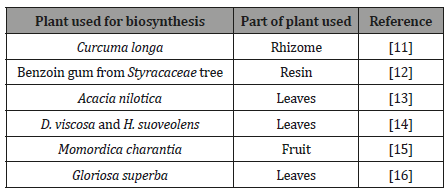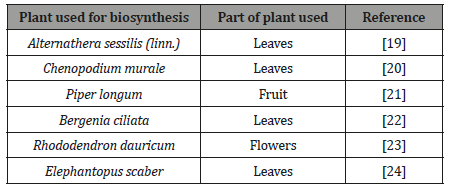 Short Communication
Short Communication
Food Industry Applications of Phyto-Synthesized Silver Nanoparticles
Ivan Moises Sanchez Hernandez, Silvia Itzel Jimenez Aguirre, Jocelyn Jazmin Ortiz Garcia, Cristal Maldonado Cervantes and Eduardo Padilla Camberos*
Center for Research and Assistance in Technology and Design of the State of Jalisco, México
Eduardo Padilla Camberos, Center for Research and Assistance in Technology and Design of the State of Jalisco, México
Received Date: August 14, 2019 Published Date: September 03, 2019
Abstract
Silver nanoparticles biosynthesized from plants represent an economical option without the use of toxic solvents, so they are friendly to the environment. Within their various applications, these products are used in the food industry as antioxidants and packaging material increasing the preservation time by controlling microbial contamination .
Keywords:Silver nanoparticles, Phytosyntesis, Antimicrobial, Antibiofilm, Antioxidant
Introduction
Studies on the chewing, size reduction and oral processing of foods have invariably focused on three solid food materials. These materials are: Optosil® a polymer based dental resin; peanuts and carrots [1-5]. Variation in the physical properties of Optosil® is carefully controlled through process control during manufacturing. The breakdown characteristics and oral processing of peanuts and the effect of roasting have been previously reviewed [6], however, natural variation in the textural characteristics of the carrots have not been reported.
Materials and Methods
Sample preparation
Silver nanoparticles have characteristics that make them unique, mainly because of their volume and contact surface ratio, which modifies their physicochemical characteristics, increasing their solubility, bioavailability, and protection of active compounds; this characteristic allows their use in various sectors such as medicine, agriculture, textile, cosmetic and food [1].
The synthesis of silver nanoparticles can be performed using physical, chemical and biological methods. The main disadvantage of physical and chemical methods is that they have a high cost in economic and environmental terms because they involve the use of dangerous or toxic substances [2]. Therefore, recent research focuses on developing methods of synthesis of silver nanoparticles, which do not use hazardous substances and are friendly to the environment, which can be achieved using biological systems with microorganisms and plants [3].
The use of plants or their extracts for the synthesis of silver nanoparticles has advantages over the synthesis with microorganisms because the process of maintaining and cultivating the microbial strains is reduced, likewise the particle size can be controlled by modifying the synthesis conditions as the pH, temperature, speed of agitation and concentration of the reducing agent. The Phyto-synthesis of silver nanoparticles has been reported with around 350 plants and their extracts [4].
The applications of Phyto-synthesized silver nanoparticles include applications in the food industry as protectors against contamination by microorganisms, avoid biofilm formation and browning in fresh cut fruits. These applications are very important because it is one of the main problems during the production, transport, and storage of food [5,6]. This review will focus on the applications of Phyto-synthesized silver nanoparticles in food systems as antimicrobial, antibiofilm and antioxidant
Antimicrobial activity
Silver nanoparticles can penetrate the bacteria cell by increase cell membrane permeability and release silver ions leading the cell to die. There are several products applied in food package or in surfaces during food processing [7-9] (Table 1).
Table 1: Application of Phyto-Synthesized Silver Nanoparticles as antimicrobials [7-9].

Antibiofilm activity
Biofilm formation is common in the food industry, this formation can be developed on different surfaces as well as in the food itself. The presence of this type of bacterial formation indicates nonhygienic conditions which affect the products [10]. Some silver nanoparticles elaborated form plants can prevent the formation of biofilms as presented [11-16] (Table 2).
Table 2: Application of Phyto-Synthesized Silver Nanoparticles as antibiofilm agents.

Antioxidant activity
Antioxidant properties of Phyto-Synthesized Silver Nanoparticles can be applied in the food industry for control the browning, weight loss rate and decay in fruits trough packing material to expand shelf life and improve preservation quality in foods [17,18]. Another application is the production of functional foods with antioxidant activity which improves the health of the population. One of the most used methods to evaluate antioxidant activity is the method known as DPPH, in the following table some works are presented where the antioxidant activity of biosynthesized silver nanoparticles allows (Table 3) [19-23].
Table 3: Research examples that prove the antioxidant capacity of nanoparticles.

Conclusion
The synthesis of silver nanoparticles with plant extracts represent an environmentally friendly option by not using hazardous materials and solvents. Phyto-synthesized silver nanoparticles are used as active packaging, with antibacterial, antibiofilm and antioxidant properties. Thus, besides increasing shelf life, this packaging system does not change the food physical characteristics. However, it is necessary to evaluate the spectrum of antimicrobial action as well as toxicological issues for safety use.
Acknowledgment
None.
Conflict of interest
No conflict of interest
References
- Bajpai VK, Kamle M, Shukla S, Mahato DK, Chandra P, et al. (2018) Prospects of using nanotechnology for food preservation, safety, and security. Journal of food and drug analysis 26(4): 1201-1214.
- Bhattacharya R, Mukherjee P (2008) Biological properties of “naked” metal nanoparticles. Adv Drug Deliv Rev 60(11): 1289-1306.
- Bhakya S, Muthukrishnan S, Sukumaran M, Muthukumar M (2016) Biogenic synthesis of silver nanoparticles and their antioxidant and antibacterial activity. Applied Nanoscience 6(5): 755-766.
- Khatoon N, Mazumder JA, Sardar M (2017) Biotechnological applications of green synthesized silver nanoparticles. J Nanosci Curr Res 2: 107.
- He X, Hwang HM (2016) Nanotechnology in food science: functionality, applicability, and safety assessment. Journal of food and drug analysis 24(4): 671-681.
- Carbone M, Donia DT, Sabbatella G, Antiochia R (2016) Silver nanoparticles in polymeric matrices for fresh food packaging. Journal of King Saud University Science 28(4): 273-279.
- Srikar SK, Giri DD, Pal DB, Mishra PK, Upadhyay SN (2016) Green synthesis of silver nanoparticles: a review. Green and Sustainable Chemistry 6(1): 34.
- Saratale RG, Shin HS, Kumar G, Benelli G, Ghodake GS, et al. (2018) Exploiting fruit byproducts for eco-friendly nanosynthesis: Citrus× clementina peel extract mediated fabrication of silver nanoparticles with high efficacy against microbial pathogens and rat glial tumor C6 cells. Environ Sci Pollut Res Int 25(11): 10250-10263.
- Chandhru M, Logesh R, Rani SK, Ahmed N, Vasimalai N (2019) One-pot green route synthesis of silver nanoparticles from jack fruit seeds and their antibacterial activities with escherichia coli and salmonella bacteria. Biocatalysis and Agricultural Biotechnology 20: 101241.
- Nahar S, Mizan MFR, Ha AJW, Ha SD (2018) Advances and Future Prospects of Enzyme‐Based Biofilm Prevention Approaches in the Food Industry. Comprehensive Reviews in Food Science and Food Safety 17(6): 1484-1502.
- Kamble SP, Shinde KD (2018) Anti-biofilm activity against gram positive bacteria by biologically synthesized silver nanoparticles using Curcuma longa. Pharm Nanotechnol 6(3): 165-170.
- Abdel Aziz, Du J, Singh H, Yi TH (2016) Antibacterial, anti-biofilm and anticancer potentials of green synthesized silver nanoparticles using benzoin gum (Styrax benzoin) extract. Bioprocess Biosyst Eng 39(12): 1923-1931.
- Reddy, Arya G, Kumari RM, Sharma N, Chatterjee S, et al. (2018) Evaluation of antibiofilm and catalytic activity of biogenic silver nanoparticles synthesized from Acacia nilotica leaf extract. Advances in Natural Sciences: Nanoscience and Nanotechnology 9(4): 045003.
- Phull, Muthamil S, Devi VA, Balasubramaniam B, Balamurugan K, et al. (2018) Green synthesized silver nanoparticles demonstrating enhanced in vitro and in vivo antibiofilm activity against Candida spp. J Basic Microbiol 58(4): 343-357.
- Malaikozhundan B, Vaseeharan B, Vijayakumar S, Sudhakaran R, Gobi N, et al. (2016) Antibacterial and antibiofilm assessment of Momordica charantia fruit extract coated silver nanoparticle. Biocatalysis and Agricultural Biotechnology 8: 189-196.
- Gopinath K, Kumaraguru S, Bhakyaraj K, Mohan S, Venkatesh KS, et al. (2016) Green synthesis of silver, gold and silver/gold bimetallic nanoparticles using the Gloriosa superba leaf extract and their antibacterial and antibiofilm activities. Microb Pathog 101: 1-11.
- Li H (2009) Effect of nano-packing on preservation quality of Chinese jujube (Ziziphus jujuba Mill. var. inermis (Bunge) Rehd). Food Chemistry 114(2): 547-552.
- Niraimathi KL, Sudha V, Lavanya R, Brindha P (2013) Biosynthesis of silver nanoparticles using Alternanthera sessilis (Linn.) extract and their antimicrobial, antioxidant activities. Colloids Surf B Biointerfaces 102: 288-291.
- Abdel Aziz Mohamed S, Mohamed S Shaheen, Aziza A El Nekeety, Mosaad A AbdelWahhab (2014) “Antioxidant and Antibacterial Activity of Silver Nanoparticles Biosynthesized Using Chenopodium Murale Leaf Extract”. Journal of Saudi Chemical Society 18 (4): 356-363.
- Reddy NJ, Vali DN, Rani M, Rani SS (2014) Evaluation of antioxidant, antibacterial and cytotoxic effects of green synthesized silver nanoparticles by Piper longum Mater Sci Eng C Mater Biol Appl 34: 115-122.
- Phull AR, Abbas Q, Ali A, Raza H, Zia M, et al. (2016) Antioxidant, cytotoxic and antimicrobial activities of green synthesized silver nanoparticles from crude extract of Bergenia ciliata. Future Journal of Pharmaceutical Sciences 2(1): 31-36.
- Mittal AK, Kaler A, Banerjee UC (2012) Free Radical Scavenging and Antioxidant Activity of Silver Nanoparticles Synthesized from Flower Extract of Rhododendron dauricum. Nano Biomedicine & Engineering 4(3).
- Kharat SN, Mendhulkar VD (2016) Synthesis, characterization, and studies on antioxidant activity of silver nanoparticles using Elephantopus scaber leaf extract. Mater Sci Eng C Mater Biol Appl 62: 719-724.
-
Eduardo Padilla Camberos, Ivan Moises Sanchez Hernandez, Silvia Itzel Jimenez Aguirre, Jocelyn Jazmin Ortiz Garcia, Cristal Maldonado Cervantes. Food Industry Applications of Phyto-Synthesized Silver Nanoparticles. Glob J Nutri Food Sci. 2(3): 2019. GJNFS. MS.ID.000537.
-
Food, Silver Nanoparticles, Plants, Toxic Solvents, Phytosyntesis, Antimicrobial, Antibiofilm, Antioxidant, Solubility, Bioavailability, Microorganisms, Microbial Strains, Food Systems, Production of Food, Transport of Food, Storage of Food, Food Package, Bacterial Formation, Health of The Population
-

This work is licensed under a Creative Commons Attribution-NonCommercial 4.0 International License.






